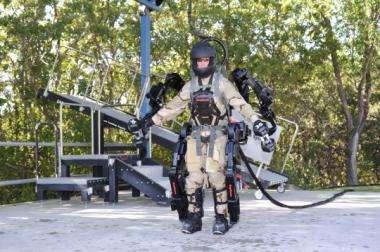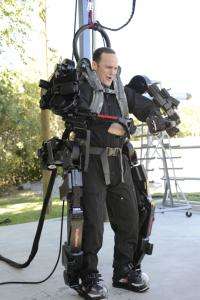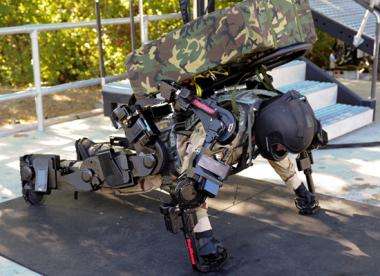September 29, 2010 weblog
The real 'Iron Man' exoskeleton does the work of two to three soldiers (w/ Video)

(�鶹��ԺOrg.com) -- A new version of what some refer to as the "Iron Man" suit was unveiled Monday by Raytheon at the company's research facility in Salt Lake City.
The Exoskeleton, also known as XOS 2, was developed for military use, both in and out of direct battle, with an enhanced design that is more resistant to environmental factors. At 95-kilograms, XOS 2 was created to be stronger, faster and lighter than it's 88-kilogram predecessor, XOS 1, while using 50 percent less power and allowing more fluid movement with the use of flexible hoses as opposed to hard, hydraulic pipes for greater efficiency for soldiers wearing the suit.
The upgrade was primarily intended to reduce strain-causing injuries, particularly orthopedic, caused by repetitive heavy lifting and exertion. One XOS 2 suit is the equivalent of two or three soldiers which allows military personnel to be reassigned to more important tasks.
Built from a combination of structures, sensors, actuators and controllers while pressured by high pressure hydraulics, the suit allows wearers to lift 200 pounds with ease, repetitively and without injury or tiring. The key to making the XOS 2 practical to the military is the reduction of power consumption. Because developers thought Lithium-ion batteries might be a danger to the wearer in close range, XOS 2 uses an internal combustion engine with electrical systems run by a wire that's tethered to the XOS 2 power source.
Though even with the many improvements, the biggest limitation is the exoskeleton's range due to the tethered cables. Engineers continue to examine the internal combustion engine and the impact of the high pressure hydraulics on power consumption. Though they have no plans to develop a better internal combustion engine, they will continue to optimize the use of high-pressure hydraulic fluid.
Tentatively planned for 2015 military use, XOS 2 will be tethered, to be followed by an untethered version three to five years later. The exoskeleton has been under development since 2000.
(c) 2010 �鶹��ԺOrg.com






















